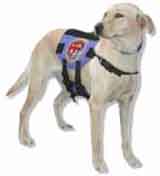Dog Behavior Problems and TrainingDog Neurosis |
|
|
A neurosis may be defined as a functional nervous disorder with no sign of disease of the central nervous system. Psychoneurosis is described as an "emotional maladaptation" due to unresolved unconscious conflicts, and may also be used to describe the condition of many so-called neurotic dogs. This means, to recognize a neurotic dog, we must identify some defective nervous behavioral functions, while ruling out physical injury or disease, such as hydrocephalus, brain tumors, etc. This can be done in some cases through neurological examinations. Urine and blood analysis can often indicate internal chemical imbalances which are of an organic cause. On the other hand, they may also indicate the presence of severe environmental stressors. Combined with behavioral information, physiologic examinations might indicate a neuroses or the basis for a psychosis. For practical purposes, a dog may be considered neurotic if he shows signs of a functional nervous disorder combined with behavior that is both abnormal and maladaptive for dogs in general. But how is a functional nervous disorder described in behavioral terms? The following descriptions are helpful: * The dog that fails to inhibit the orienting (alerting) response to stimuli that occurs repeatedly and are known to the animal to be neither harmful nor rewarding. These dogs are almost always in a state of anxiety. * The dog that responds to novel objects, sounds, touches, movements and even odors with exaggerated active or passive defensive responses. These dogs often lack adequate early social experience. * The dog that fails to retain (in some cases, even to develop) voluntary or involuntary conditioned reflexes. This cannot be applied to the dog's total behavior, but usually is pertinent to a failure to form and/or retain learned associations involving defense and social behaviorisms. * The dog that displays hyperkinesis. Signs include excessive salivation, elevated pulse and respiration, abnormally low urine output, and increased energy metabolism revealed through excessive, sometimes stereotyped activity, especially in close confinement. * Displays fixations on objects, exhibiting ritualized behavior, usually repetitive and with no apparent objective. "Obsessive-compulsive" is the current diagnostic label of choice. While it is often treated with drugs, careful diagnosis shows that these dogs are suffering from frustration due to a lack of function in their lives. They are "making work," and receiving internal neurochemical rewards.Back to the Dog Behavior Problems and Training page
| |
|
Related News About Dogs ' ); // get rid of newsfeed display by carp CarpConf('poweredby',''); CarpCacheShow('http://dogguidance.com/dogblog/?feed=rss2'); ?>
|
|
|
|
|
|
Copyright © 2006-2007 dogguidance.com |


